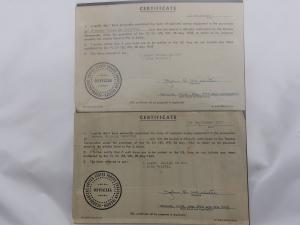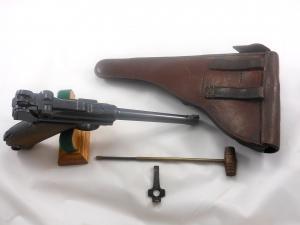A Veteran's Luger
by Harry Viezens
When I was still doing horseshoeing, I used to pick up really neat stuff from my clients. I have been known to come home with boats, antiques, fresh meats and poultry, guns, and pretty much anything else that caught my fancy.
I guess it sometimes drove Marcia my wife, kind of nuts as to what I may wind up with! Gotta say however she was a pretty good sport about what I dragged home! I certainly was not shy in letting my customers know I was a gun collector. I did do horseshoeing services in trade for some firearms my clients had. As a matter of fact I still have in my collection a really nice Winchester Model 1892 Rifle I acquired in this manner. Heck, I may save that story for a future article!

Anyways, back to this story, I was at a client’s farm doing his saddle horses. As part of the general conversation, he told me that he mentioned me to a friend of his, as wanting to buy old guns. His friend, I was told, had a pistol he wanted to sell. I had the client call his friend and have him bring the pistol for me to look at. The guy showed up with a Imperial Navy Luger Rig with it’s capture papers from World War Two. It’s a model 1914 Navy in about 96% condition dated 1917 all matched serial numbers with the exception of the magazine which was 146 serial numbers apart from the pistol. Included was a nice LZA marked holster with it’s correct Crown M tool, sadly the cleaning rod was missing. So Yeah, a really nice Luger! We were able to work out a deal for this pistol. Made plans to meet the next day to conclude the deal. During the exchange that day, I found out that in fact his dad was the one who liberated this pistol. Other than that I did not get any more details on this gun.

When I got back to my place I cleaned up the pistol, grabbed a box of ammunition and went out to my range to see how it shoots. Man! Did this Luger shoot nice! It was nicely balanced and those navy sights were really nice to use, much better than the standard army model Luger sights. All in all a really sweet pistol to shoot! After giving this pistol a final cleaning my next step was to do the research and possible history on this gun. Found out these model 1914 Navy’s were mostly used by Imperial naval and marine units stationed in Belgium during World War One. Most of these pistols were not issued with a shoulder board stock. Because of the shoulder stock not being issued the holsters were either modified or made to be used and carried with a belt rather than the standard style with a shoulder strap to carry the pistol and stock. The holster that I have is originally fitted to be used as a belt holster. The quality of this holster is first rate, really nice leather and workmanship throughout. As for the missing cleaning rod, I was able to locate a original cleaning rod to complete this rig.
Those navy rods I found out are really expensive!, just lucky to find one though. The good thing was that this pistol survived World War One and the in-between war years with out being rebuilt, reconditioned or in any way altered. You just wonder if it was taken home by a German veteran or was stored in a forgotten naval storehouse or even if it was even issued during World War One, who knows?
I did however make a effort to look up the soldier who captured the pistol. Found out he was a sergeant in General Patton’s third army during the war. To my surprise! This former soldier lives in my town! I looked him up in the local phone book and gave him a call. I explained the purpose of the call, mainly any history he could give me concerning this pistol. We made a date to meet at a local coffee shop. I still can recall how excited I was to meet this person, let alone hear from him how he acquired this gun.
When we met, he was really nice and very outgoing. He did state that he was surprised and disappointed that his son sold his pistol. He told me that he gave this pistol to his son several years earlier as a gift. I offered to sell the pistol back to him as I did not wish to create any hard feelings in his family. He graciously declined my offer to do so, stating what’s done is done. He went on to tell me that in the last days of the war in Europe many units of the German army were surrendering to American and British forces in mass. The Germans certainly did not want to surrender to the Russians! He told me he was out on a recon patrol when he encountered a German Division on the road. He thought he was in real trouble! Turns out the German Oberst (Colonel in our rank) wished to surrender himself and his men! The sergeant spoke fluent German and was able to work out the details for the surrenders. Oberst, as part of the surrender proceedings gave the sergeant the pistol, he was carrying. He kept this pistol all those years until he gave it to his son. He also gave me a copy of the photo he took of the surrender of the German division.

Unfortunately, this photo did not reproduce very well to show with this article. Boy! what a neat story! He also told me he was born in Germany and emigrated to America in 1929. He joined the army in 1942 and was mustered out in 1946. He also served as a interpreter at the Nurnberg trials in 1946. As you can imagine he was really interesting to listen to. This talk really made me appreciate this Luger even more.
As a Luger collector,this documented history of this pistol really makes this gun stand out. It’s not often that a collector can find out the history and background of a firearm. This gun served Germany in two World Wars and survived the peace as a war captured souvenier. Not too many guns can say that and back it up. I am very careful to preserve this history and documents I have on this Luger. It’s important to do this,for once the history is lost it’s gone for good. I as a collector,am only the caretaker for this pistol for a period of time until the next collector takes my place. So if you have a gun with some interesting history, be sure to write it all down and document it as much as possible. This can be important to the possible value of the firearm or maybe to your family history or to related events in the past. That’s what makes collecting so much fun! You never know what kind of history you may dig up with your firearm if you do a little digging and research.
Until Next Time
Harry

